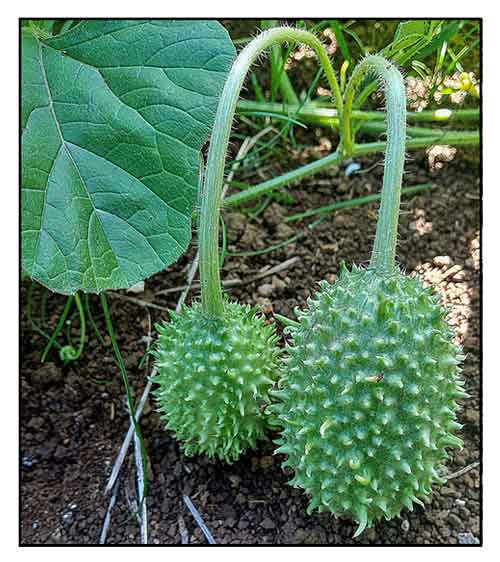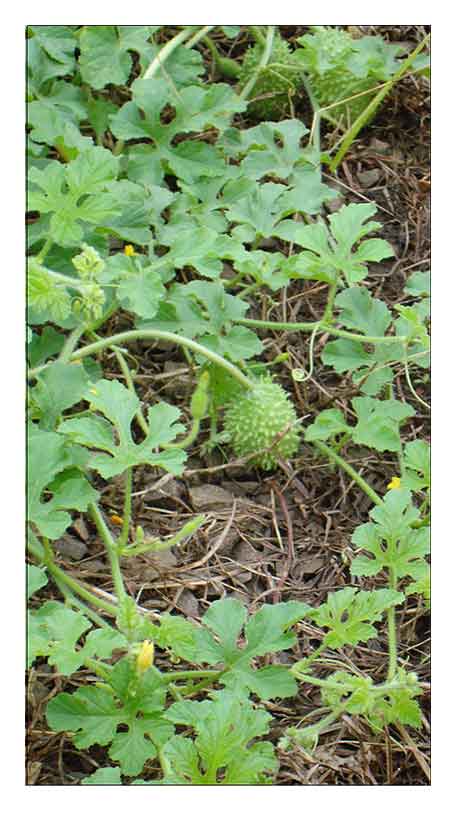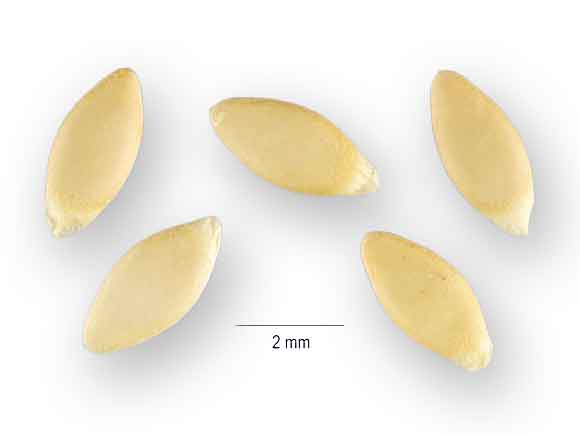
Family • Cucurbitaceae
Badunga
Gherkin
Cucumis anguria Linn.
BUR GHERKIN / BUR CUCUMBER
| Scientific names | Common names |
| Cucumis anguria L. | Badunga (Tag.) |
| Accepted infraspecifics | Burr cucumber |
| Cucumis anguria var. anguria | Bur gherkin (Engl.) |
| Cucumis anguria var.longaculeatus J.H.Kirkbr. | Burr gourd (Engl.) |
| Cackrey (Engl.) | |
| Gooseberry gourd (Engl.) | |
| Maroon cucumber (Engl.) | |
| West Indian gourd (Engl.) | |
| Wild Indian gherkin (Engl.) | |
| Cucumis anguria L. is accepted. KEW: Plants of the World Online | |
| Other vernacular names |
| FRENCH: Concombre antillais, Cornichon des Antilles, Ti-concombre, Macissis. |
| PORTUGUESE: Pepino das Antilhas, Cornichão das Antillas, Machiche, Maxixe. |
| OTHERS: Cassongo, Chikanyanga, Chikopa, Chipokolo, Gpareberry gourd, Ingolowe, Jerusalem cucumber, Kasongwe, Muchacha, Muhawa. |
Botany Constituents Properties • Bitterness and Toxicity: It is best to eat wild cucumbers when young as the bitterness increases considerable as the fruit ripens. Bitterness attributed to bitter principles, cucurbitacins, which are tetracyclic triterpenoids. Cucurbitacins are one of the most bitter substances known and are extremely toxic to mammals. In Cucumis anguria, the main brittle principle is cucurbitacin B (C32H48O8), with much smaller amount of cucurbitacin D (C30H46O7) and traces of cucurbitacins G and H. Fruit juice is highly toxic to rats with LD50 1.6 mg/kg. Toxicity is reduced more than 100-fold if juice is boiled before using. (4) • Antimicrobial / Fruit: Ethanol-methanol-chloroform and ethyl acetate were used to extract bioactive compounds from fruits of C. anguria to screen for antibacterial and antifungal activities against selected human clinical pathogens by disc diffusion method. Maximum antimicrobial activity was observed in ethanolic extracts compared to other extracts. (5) • Antioxidant / Phytochemicals: Study investigated the phytochemicals and antioxidant capacity of Cucumis anguria. Results showed superior antioxidant activity compared to standard antioxidants, tannic acid and ascorbic acid, which was attributed hugely to flavonoids and saponins. (see constituents above) (6) • Silver Nanoparticles / Antibacterial / Leaves: Study reports on the green, simple, cost-effective synthesis of silver nanoparticles using wild Cucumis anguria leaf extract as reducing and capping agents. By disc diffusion method, the synthesized AgNPs showed enhanced antibacterial activity against both S. aureus and E. coli. (7) • Corrosion Inhibition of Mild Steel / Leaf: Study evaluated leaf extract for phytochemicals and effect in inhibiting corrosion of mild steel in 1M H2SO4. Spectroscopy confirmed the existence of a protective film created by C. anguria leaf extract on metal surface (mild steel). Maximum inhibition efficiency of 92.39% was reached using 250 ppm of C. anguria leaf extract inhibitor. (see constituents above) (8) • Antioxidant / Antimicrobial / Hairy Root Cultures: Study evaluated the production of secondary metabolites from hairy root cultures of gherkin (C. anguria) along with antioxidant and antimicrobial activities using explants from in vitro seedlings inoculated with Agrobacterium rhizogenes strain for the induction of hairy roots. Total phenolics, flavonoid content, antioxidant and antimicrobial activities were higher in hairy roots compared to non-transformed roots. Hairy root cultures showed greater potential for production of important phenolic compounds and uses of their biological activities. (9) Availability |
November 2022
![]()
 |
| PHOTOS / ILLUSTRATIONS |
IMAGE SOURCE: Photograph: Cucumis anguria fruits and leaves / Eugenio Hansen / Creative Commons Attribution-Share Alike 3.0 / click on image to go to source page / Wikimedia Commons |
| OTHER IMAGE SOURCE: Photograph: Cucumis anguria fruits / Filo gen / Creative Commons Attribution-Share Alike 4..0 / click on image to go to source page / Wikimedia Commons |
| OTHER IMAGE SOURCE: Cucumis anguria seeds / Steve Hurst @ USDA-NRCS PLANTS Database / Public Domain / USDA |
Additional
Sources and Suggested Readings |
• |
DOI: It is not uncommon for links on studies/sources to change. Copying and pasting the information on the search window or using the DOI (if available) will often redirect to the new link page. (Citing and Using a (DOI) Digital Object Identifier) |
| List of Understudied Philippine Medicinal Plants |
• |
 |



 Uses
Uses